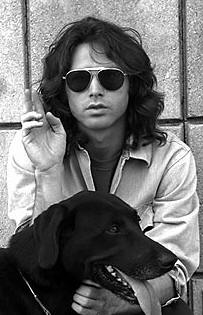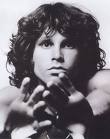Icon Jim + Time
Kathleen A. Riddell
The music of Jim Morrison, and the man himself, was largely thought of as an anomaly in both Popular and Psychedelic music. This statement was quite true. “The Doors,” led by Morrison, weren’t content to limit themselves to one genre or movement.

The application of a diamond analogy, which Sugerman applies to “The Doors," is well suited. The band didn't exist as four independent men; their co-dependence was what made them both work, as it should, and ultimately fail. Morrison moved too quickly, musically, intellectually and spiritually. His vision was one society, then and now, couldn’t or wouldn’t accept by band members, management or the industry.


Jim Morrison’s “rational derangement of the senses,” through drug use, particularly, LSD, enabled him to create his music and leave an unforgettable mark on pop music, despite his relatively short life and career. In large part, the mythos of “The Doors” is attributable to two things. First, Morrison, the lead singer and lyricist for the band, died in 1971 at the age of 27, after a prolonged battle with substance abuse. Second, the Psychedelic Era particularly, the summer of 1967 – the summer-of-love – has been mythologized more than any era in the history of pop music.
Timothy Leary, in “Some Superficial Thoughts On The Sociology Of LSD,” claimed it was the demographic of the post-war Baby Boom, the psychological, the humanist movement and, most importantly, the philosophical climate that made the moment. The emphasis on self-exploration, which had been stressed by Thoreau, as well, brought about the possibility for consciousness raising, drug exploration and promise likely not realized.
Morrison was cutting-edge, for his time, and probably would be today. The music of “The Doors” was not simply rock. It was alchemy, a blend of many different and, perhaps, still undefined genres. Morrison, through music and drug exploration, courted his muse, lived a brief life and ultimately died, like Joplin and Hendrix, too young.
The most important inspiration for Morrison was a 19th century poet, Arthur Rimbaud, who “advocated a systematic rational derangement of the senses.” Morrison was not the first, nor the last, to live by this tenant. In the following quotation, he describes this influence on his life,
I've always been attracted to ideas that were about revolt against authority,” said Morrison. “I like ideas about the breaking away or overthrowing of established order. I am interested in anything about revolt, disorder, chaos - especially activity that seems to have no meaning. It seems to me to be the road toward freedom - external revolt is a way to bring about internal freedom. Rather than starting inside, I start outside – reach the mental through the physical.
Morrison abided closely to this tenant, but his interest in chaos showed an understanding that this would lead to his “End,” as he often spoke. Early in his career, this formula or ritual, as some would describe LSD use for this purpose, worked. With time, Morrison became engrossed with the painful realization of his limited utility in a passive world. Whether Morrison anticipated this end or simply got caught in a very dark place, remains as much a mystery as the circumstances of his death.
LSD use was ritualized and the guide for first time users by a guru, according to a collection of essays recounting the subjective experiences of LSD users in the 1960s and early 1970s. This practice, wrote Zinberg, soon became a social sanction – “seek the advice of an experienced user, and never trip the first time without the presence of an experienced user.” In the following quotation of Morrison’s song “The End,” one could see Morrison behaving much like the experienced user, the guru. “There's danger on the edge of town,” wrote Morrison. “Ride the king's highway, baby. Weird scenes inside the gold mine. Ride the highway west, baby. Ride the snake; ride the snake. To the lake, the ancient lake, baby. The snake is long, seven miles. Ride the snake...he's old, and his skin is cold. The blue bus is callin' us. The blue bus is callin' us. Driver, where you takin' us?”
Many believe this lyric, “The End,” is an arrogant attempt by Morrison to masquerade as Freud. His numerous references to Freud’s most primitive symbol of sexuality – a snake – and his controversial placing of the Oedipal Complex in the song makes one wonder if the claim is right. These attempts, as well as other claims of an inebriated Morrison exposing himself on stage, are really, I believe, his desire to make sense of a difficult past, and an attempt to raise others from this a similar unconsciousness.

The double-edged sword, which both enabled Morrison to achieve hat he did and to destroy himself, was his belief in an “artist’s duty to do everything possible to increase his powers of perception.” Danny Sugerman describes how Morrison articulated this belief – “Jim’s fondness, and search for the unknown is well documented in the following pages.” There are things known, Jim would say in a quote often attributed to William Blake but in fact Jim’s own, “and there are things unknown, and in between are the doors.” But, Blake did say, in his first Proverb of Hell, “The road to excess leads to the palace of wisdom.” And the next line down, “Prudence is a rich and ugly old maid courted by Incapacity.” It needn’t be added that Jim didn’t court the maid and courted capacity whenever he could. Jim drank and yelled and pleaded, cajoled and danced in inspiration to unite the band, to ignite the audience, to set the night on fire, once and for all, forever.”
Morrison may have felt the restraint of decorum and a passive existence. One thing to which he continued to adhere was his unwillingness to compromise his ideology or his art. It would likely be arguable that if Morrison had lived at a different pace that the ‘mythos’ that surrounded this man would be nonexistent.
Danny Sugerman noted, that in the end, Morrison drank mainly because “that’s what alcoholics do!” In my opinion, Morrison was not letting himself down or succumbing to the reality of a muse he pursued far too often and readily. Those who couldn’t or wouldn’t comprehend his message forced the “bottle to his mouth.”
The argument, that Morrison succumbed to substance abuse, most notably LSD, is true. Reality, the standard, was simply not enough for people like him. His vision, understandably, became lost in his medicated decline, but the collective belief and action against his ideologies served as a catalyst.
Jim Morrison isn’t comprehendible by looking just at ‘Jim,’ himself. Danny Sugerman wrote that, “to get the best view of Jim Morrison you must go through “The Doors” and the most important thing to remember about “The Doors” is that they were a band, and each individual formed a side of the diamond that was whole.” Sugerman perhaps stands too close to the band. “The Doors” weren’t just a band, in the same sense Jim Morrison was not just a man. Each was a sum of its parts and a contributor to the legacy that was left.
Click here to read about what influenced the work of Jim Morrison, and how.
Bibliography
------------
Harriot Linton Barr and Robert J. Langs (1972), LSD: Personality and Experience. Wiley-Interscience.
Stuart Borthwick and Ron Moy (2004). Popular Music Genres. Routledge.
Lester Grinspoon and James B. Bakalar, editors (1983). Psychedelic Reflections. Human Sciences Press.
Jack Kerouac (1991 [1957]). On The Road. Penguin Books.
William Marshall and Gilbert W. Taylor (1967). The Art of Ecstasy. Burns & MacEachern Limited.
"The Doors" Official Website is http://www.thedoors.com, and was accessed on 5 March 2006 for this piece.
Kathleen Riddell is a doctoral candidate at the University of Waterloo. Her research focus is pop culture, especially how Johnny Cash, Jimi Hendrix and John Lennon are commonly spoken and thought of in religious terms.
Click above to tell a friend about this article.
Recommended
- David Simmonds
- Tempest at a Tea Party
- Buy Canadian Cucumbers
- Explosive Campaign

- Jennifer Flaten
- Tour du Cupcake
- A Rare B-day
- Let's Hear it for Mom

- M Alan Roberts
- Checkmate
- Fire Ring
- Learning to Live

Recommended
- Matt Seinberg
- Thanksgivings Past
- Hot Cars in Summer
- Deliveries

- Streeter Click
- Tanna Frederick
- Ode to Groucho
- Phil Collins: Into the Air Video

- JR Hafer
- The Kingston Trio
- Habit-forming
- Rosko

Recommended
- Jane Doe
- Buying an Amp
- Watchman
- Can Trump Win

- M Adam Roberts
- The Builder
- No Greater Love
- One More Round

- Ricardo Teixeira
- There is a Light
- Harmony
- The Unicorn





